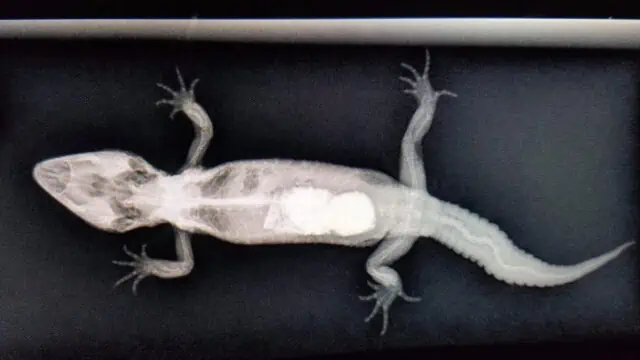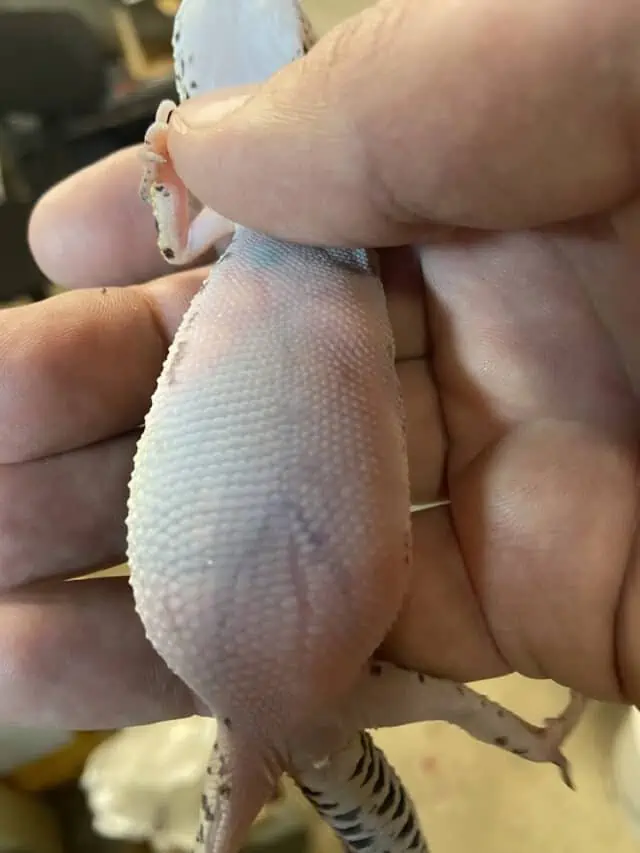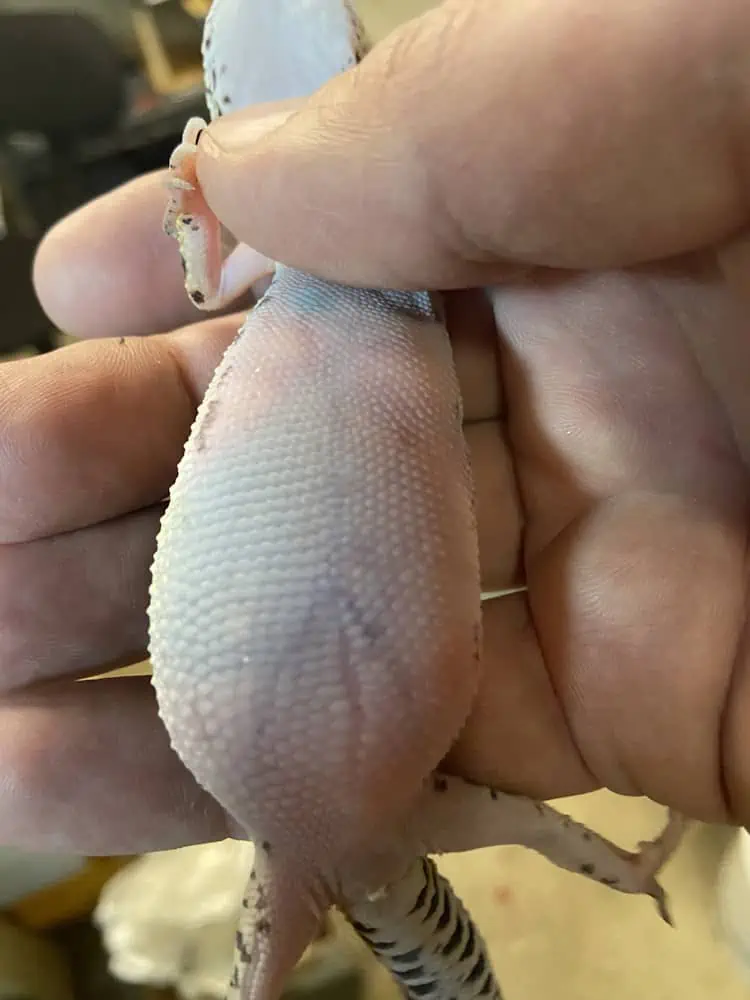Leopard gecko impaction is a serious health concern where these small reptiles experience blockages in their digestive tracts, often as a result of certain husbandry missteps or dietary choices. Recognizing, treating, and most importantly, preventing this condition is essential for any leopard gecko owner aiming to keep their pet in optimum health.
This guide delves into the causes, symptoms, risk factors, and the ways you can both treat and avoid impaction in leopard geckos.
Leopard Gecko Impaction – What Is It
Before we dive into the details, it’s crucial to have a clear understanding of what impaction means when it comes to leopard geckos. Impaction occurs when a solid mass forms inside the gecko’s digestive tract, causing blockages and, if left untreated, serious health problems. This is typically a result of the gecko ingesting substances that it can’t properly digest, combined with other factors that hinder its digestion process.
Common Causes of Impaction in Leopard Geckos

The root cause of impaction in leopard geckos often traces back to poor diet and improper husbandry. These small reptiles have specific dietary and environmental needs that, when unmet, can lead to severe health issues.
First and foremost, a poor diet plays a significant role. If leopard geckos consume food items that are difficult for them to digest, it can result in blockages. For example, feeding them insects that are too large or those not gut-loaded properly can be problematic. Additionally, if their environment doesn’t mimic their natural habitat, it can further contribute to digestion issues.
Dehydration is another key factor contributing to impaction. Leopard geckos require a consistent intake of water to keep their digestive system running smoothly. Inadequate water intake can lead to the food they’ve consumed hardening in their intestines, which can cause a blockage. Ensuring they have access to fresh water at all times is essential.
Lastly, the lack of a humid hide in their enclosure can compound these problems. A humid hide provides a moist environment for the gecko, which not only aids in the shedding process but also helps maintain proper hydration levels. Without it, the gecko can become dehydrated more quickly, exacerbating the risk of impaction.
Symptoms of Impaction in Leopard Geckos
Detecting impaction early in leopard geckos is crucial to ensure timely intervention and care. Being aware of the signs can make all the difference in maintaining your pet’s health. Various symptoms can indicate a potential blockage in your gecko’s digestive tract, each offering insight into the severity of the problem.
Loss of Appetite
One of the first and most noticeable symptoms of impaction in leopard geckos is a loss of appetite. When there’s a blockage in their digestive tract, they naturally feel full or uncomfortable, making them less inclined to eat. But impaction isn’t the only cause; other digestive issues can also deter them from feeding. Even respiratory infections can lead to it, so it’s not a clear sign on its own.
Addressing the root of appetite loss is essential. Ignoring or overlooking this symptom can lead to more severe health concerns, including malnutrition and severe digestive complications. If your gecko isn’t eating, it’s vital to seek veterinary care promptly.
Aside from a diminished interest in food, there are other indicators to be on the lookout for. Weight loss is a direct consequence of reduced food intake and can be a clear sign of underlying issues. Additionally, a lack of growth, especially in younger geckos, can also be a red flag.
Bloated Belly

A bloated belly can be an alarming sight in leopard geckos and is often a clear sign of impaction. When food or foreign objects get lodged in the digestive tract, it can lead to swelling or distention in the belly as the blockage builds up. This bloating is not just a cosmetic concern—it’s a signal that something is wrong internally.
It’s crucial to observe your gecko closely if you suspect impaction. Regularly checking their belly for any noticeable swelling can help in early detection. The belly should feel soft and pliable; any hardness or distended appearance should raise concern.
If you do spot a bloated belly, immediate action is paramount. Waiting or hoping the issue resolves on its own can lead to severe health complications. At the first sign of bloating, consult with an experienced reptile vet. They can assess the situation, provide a proper diagnosis, and guide you on the necessary steps to address the impaction and restore your gecko’s health.
Poor Bowel Movements
Regular bowel movements are an indicator of a healthy digestive system in leopard geckos. When suffering from impaction, these geckos often display poor bowel movements, which can be easily noticeable to the attentive owner. Constipation or difficulty in pooping is not just an inconvenience for the gecko; it’s a significant sign that there’s a blockage or other digestive issue at play.
The environment in which a leopard gecko lives plays a pivotal role in their digestive health. Providing a warm side in the tank ensures that the gecko has the right temperature to aid in digestion. If the tank is too cold, it can slow down the digestive process, increasing the risk of constipation.
Diet also has a substantial role in preventing impaction and promoting regular bowel movements. A varied diet, supplemented with essential vitamins and calcium, can keep their digestive system running smoothly. Feeding them a balanced mix of appropriate food items ensures they receive the necessary nutrients and reduces the risk of digestive complications.
Blue Spot on the Abdomen
One of the more distinctive symptoms of impaction in leopard geckos is the appearance of a blue spot on the abdomen. This isn’t a typical characteristic and should always be a cause for concern. This blue spot is not just a random discoloration; it’s a worrisome sign indicating potential impaction issues and blockages in the digestive tract.
The blue spot results from an accumulation of waste material or gas that the gecko is unable to expel due to the blockage. As the waste builds up, it can cause pressure and lead to this distinctive blue discoloration. The presence of such a sign is a clear indication that the gecko’s digestive system is not functioning correctly and that there is a buildup that the body can’t naturally pass.
Ignoring a blue spot on a leopard gecko’s abdomen can be detrimental. If left untreated, this impaction can lead to serious health complications, making it imperative to address the issue immediately.
Risk Factors for Impaction in Leopard Geckos
Impaction in leopard geckos isn’t just a random occurrence; there are several risk factors that can elevate the chances of this health concern manifesting. While understanding the symptoms is crucial, it’s equally vital to be aware of these predisposing factors.
Feeder Insects Not Being Gut Loaded Properly
Properly gut loading feeder insects is paramount when it comes to the health and nutrition of leopard geckos. Essentially, gut loading means feeding the insects a nutritious diet before they’re given to the gecko. This ensures that the reptiles are not just consuming the insects but also the beneficial nutrients these insects have ingested.
When these insects aren’t gut loaded adequately, they can lack essential nutrients. This deficiency, in turn, can lead to impaction in leopard geckos.
Inadequate gut loading can cause the feeder insects to have harder exoskeletons or consist of indigestible materials, increasing the risk of blockages in the gecko’s digestive system.
Loose Substrate in the Enclosure
The use of loose substrate in a leopard gecko’s enclosure poses several potential risks and issues. One of the primary concerns is the risk of impaction. When geckos come into contact with these small, loose particles, they might accidentally ingest them, especially while hunting or feeding.
Over time, these ingested particles can accumulate in the gecko’s digestive system, leading to impaction. This is a condition where the ingested substrate forms a blockage, preventing the gecko from passing waste normally.
Given the dangers associated with loose substrates, it’s vital to consider alternative options that don’t carry the same risks. Some safer alternatives for leopard geckos include paper towels, reptile carpet, or even slate tiles. These options reduce the risk of ingestion and subsequently, the risk of impaction.
Lack of Exercise and Movement
Exercise and movement are essential for leopard geckos to maintain their overall health and, importantly, to prevent impaction. Just like in other animals, regular movement helps in the proper functioning of the digestive system.
A lack of exercise can slow down the digestive process, potentially leading to issues like constipation, which in turn can contribute to impaction.
To promote active behavior and prevent digestive problems in leopard geckos, it’s essential to offer an environment that encourages movement. Providing a spacious and enriched enclosure is a step in the right direction. Incorporating climbing structures and hiding spots can stimulate exploration and physical activity.
Additionally, allowing your gecko regular out-of-enclosure time in a controlled environment can further ensure they get the movement they need.
Prevention and Treatment of Impaction in Leopard Geckos
Impaction in leopard geckos can be a serious health concern, leading to discomfort and potentially life-threatening complications. While understanding the symptoms and risk factors is crucial, it’s equally important to be well-informed about the preventive measures and treatments available.
A proactive approach, combined with prompt medical interventions when needed, can significantly reduce the chances of impaction and ensure the well-being of these beloved reptilian pets.
Establishing a Balanced Diet
A balanced diet is paramount for the health and longevity of leopard geckos. Introducing a variety of appropriate food items ensures that these reptiles receive all the essential nutrients they need. This in turn helps them fight various diseases, such as mouth rot. Protein is a vital component of their diet, and food items like crickets, mealworms, and silkworms serve as excellent protein sources.
Incorporating green veggies, such as collard greens and mustard greens, not only provides the geckos with essential vitamins and minerals but also ensures fiber intake and hydration, which are crucial for smooth digestion.
Opting for smaller mealworms is a wise choice, as their size reduces the risk of impaction, ensuring that the leopard gecko can digest them without any complications.
Ensuring Fresh Water Is Available at All Times
In a leopard gecko enclosure, it’s crucial to prioritize the availability of fresh water. A simple yet effective method is to provide a shallow water dish, which allows the gecko easy access to clean and fresh water. This design ensures that the gecko won’t accidentally submerge itself or struggle to reach the water.
To maintain the freshness of the water and to prevent the possibility of dehydration, it’s essential to check the water dish daily, refilling it as necessary.
Providing a Humid Hide or Moist Hide Area for the Gecko to Retreat To
For leopard geckos, creating a specialized space known as a humid hide or moist hide area is invaluable. This distinct area, which the gecko can retreat to, plays a dual role in their well-being.
Firstly, it ensures proper humidity levels, which are fundamental for the gecko’s skin health and comfort. Secondly, a moist hide facilitates healthy shedding, preventing any complications or incomplete molts.
To set up a successful humid hide or moist hide, one can utilize various materials. Typically, moisture-retaining substrates like sphagnum moss or damp paper towels are used to line the bottom of the hide. Once filled, the hide should be placed in a location within the enclosure where it can maintain a consistent level of humidity, preferably away from direct heat.
Regular checks should be conducted to ensure that the substrate remains damp, replacing it as needed to maintain the hide’s humidity.





